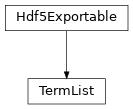TermList¶
full name: tenpy.networks.terms.TermList
parent module:
tenpy.networks.termstype: class
Inheritance Diagram

Methods
|
Initialize self. |
|
Load instance from a HDF5 file. |
|
Initialize from a list of terms given in lattice indices instead of MPS indices. |
|
Order and combine operators in each term. |
|
Export self into a HDF5 file. |
Convert to |
-
class
tenpy.networks.terms.TermList(terms, strength=1.0)[source]¶ Bases:
tenpy.tools.hdf5_io.Hdf5ExportableA list of terms (=operator names and sites they act on) and associated strengths.
A representation of terms, similar as
OnsiteTerms,CouplingTermsandMultiCouplingTerms.This class does not store operator strings between the sites. Jordan-Wigner strings of fermions are added during conversion to (Multi)CouplingTerms.
- Parameters
terms (list of list of (str, int)) – List of terms where each term is a list of tuples
(opname, i)of an operator name and a site i it acts on. For Fermions, the order is the order in the mathematic sense, i.e., the right-most/last operator in the list acts last.strengths ((list of) float/complex) – For each term in terms an associated prefactor or strength. A single number holds for all terms equally.
-
terms¶ List of terms where each term is a tuple
(opname, i)of an operator name and a site i it acts on.
-
strengths¶ For each term in terms an associated prefactor or strength.
- Type
1D ndarray
Examples
For fermions, the term \(0.5(c^\dagger_0 c_2 + h.c.) + 1.3 * n_1\) can be represented by:
>>> t = TermList([[('Cd', 0), ('C', 2)], [('Cd', 2), ('C', 0)], [('N', 1)]], ... [0.5, 0.5, 1.3]) >>> print(t) 0.50000 * Cd_0 C_2 + 0.50000 * Cd_2 C_0 + 1.30000 * N_1
If you have a
Lattice, you might also want to specify the location of the operators by lattice indices insted of MPS indices. For example, you can obtain the nearest-neighbor density terms without double counting each pair) on aTriangularLattice:>>> lat = tenpy.models.lattice.Triangular(6, 6, None, bc_MPS='infinite', bc='periodic') >>> t2_terms = [[('N', [0, 0, u1]), ('N', [dx[0], dx[1], u2])] ... for (u1, u2, dx) in lat.pairs['nearest_neighbors']] >>> t2 = TermList.from_lattice_locations(lat, t2_terms) >>> print(t2) 1.00000 * N_0 N_6 + 1.00000 * N_0 N_-5 + 1.00000 * N_0 N_5
The negative index -5 here indicates a tensor left of the current MPS unit cell.
-
classmethod
from_lattice_locations(lattice, terms, strength=1.0, shift=None)[source]¶ Initialize from a list of terms given in lattice indices instead of MPS indices.
- Parameters
lattice (
Lattice) – The underlying lattice to be used for conversion, e.g. M.lat from aModel.terms (list of list of (str, tuple)) – List of terms, where each term is a tuple
(opname, lat_idx)with lat_idx itself being a tuple(x, y, u)(for a 2D lattice) of the lattice corrdinates.strengths ((list of) float/complex) – For each term in terms an associated prefactor or strength. A single number holds for all terms equally.
shift (None | tuple of int) – Overall shift added to all lattice coordinates lat_idx in terms before conversion. None defaults to no shift.
- Returns
term_list – Representation of the terms.
- Return type
-
to_OnsiteTerms_CouplingTerms(sites)[source]¶ Convert to
OnsiteTermsandCouplingTermsPerforms Jordan-Wigner transformation for fermionic operators.
- Parameters
sites (list of
Site) – Defines the local Hilbert space for each site. Used to check whether the operators need Jordan-Wigner strings. The length is used as L for the onsite_terms and coupling_terms.- Returns
onsite_terms (
OnsiteTerms) – Onsite terms.coupling_terms (
CouplingTerms|MultiCouplingTerms) – Coupling terms. If self contains terms involving more than two operators, aMultiCouplingTermsinstance, otherwise justCouplingTerms.
-
order_combine(sites)[source]¶ Order and combine operators in each term.
- Parameters
sites (list of
Site) – Defines the local Hilbert space for each site. Used to check whether the operators anticommute (= whether they need Jordan-Wigner strings) and for multiplication rules.
See also
order_and_combine_term()does it for a single term.
-
classmethod
from_hdf5(hdf5_loader, h5gr, subpath)[source]¶ Load instance from a HDF5 file.
This method reconstructs a class instance from the data saved with
save_hdf5().
-
save_hdf5(hdf5_saver, h5gr, subpath)[source]¶ Export self into a HDF5 file.
This method saves all the data it needs to reconstruct self with
from_hdf5().This implementation saves the content of
__dict__withsave_dict_content(), storing the format under the attribute'format'.